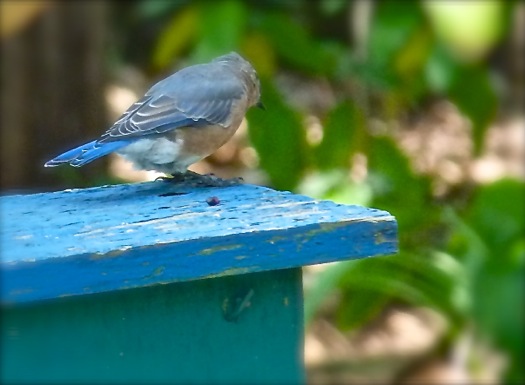Tips for Attracting Bluebirds
 Sunday, October 12, 2014 at 2:00PM
Sunday, October 12, 2014 at 2:00PM Recently a flock of bluebirds came by to check out the bluebird house. They flew around the house, examining it from top to bottom. 

 It was an old house in need of refurbishment, and I was concerned because squirrels had recently been chewing on the entry so that it was much larger than was desirable. Bluebirds choose nesting sites well ahead of time, so a few days later I repainted the house and added a predator guard that covered up the old hole and created a new entry. A copper portal cover will prevent squirrels from enlarging the hole. It looks like a new birdhouse!
It was an old house in need of refurbishment, and I was concerned because squirrels had recently been chewing on the entry so that it was much larger than was desirable. Bluebirds choose nesting sites well ahead of time, so a few days later I repainted the house and added a predator guard that covered up the old hole and created a new entry. A copper portal cover will prevent squirrels from enlarging the hole. It looks like a new birdhouse! The new predator guard on the refurbished bluebird house will prevent opening of the box for cleaning, so I attached it with one screw so that I can easily remove it.
The new predator guard on the refurbished bluebird house will prevent opening of the box for cleaning, so I attached it with one screw so that I can easily remove it.
This house has had bluebirds in it since the first year we put it up. I painted it bright turquoise and cobalt blue after reading that bluebirds can see colors very well and are attracted to the color blue. Perhaps that was the key, but there are several important requirements for creating a welcoming habitat for bluebirds.
Just any old bird house won't do. The house needs to have an entry hole one and one half inches in diameter. Wood is the safest material for the box as this mimics a natural cavity. The house needs to have ventilation and drainage holes. One should purchase a house designed with specific bluebird requirements in mind, or you can get bluebird house plans and build your own. If you paint it, make sure you use non-toxic paint and do not paint the interior of the house. Bluebirds do not clean out old nests but sometimes will build on top of old ones. This can promote disease, so be sure your box has easy access to the nesting cavity so that you can clean it out after the young have fledged.After the babies leave the nest, it is time to clean out the box. Bluebirds often will raise two families in a single season, so clean out after each one.
The house should be mounted on a pole between four and seven feet off the ground. Never put it on a tree trunk, as this will provide a superhighway for squirrels and other predators. Site the house so that it faces away from the prevailing winds and is out of hot midday sun. There should be small trees or shrubs nearby to provide safe places to perch. Conifers and other evergreens will provide protection from predators and shelter during harsh weather. The perfect location is at the edge of a field, where the birds can find plentiful insects. My own property is partially wooded. My bluebird house is at the edge of a clearing under tall trees. It is not perfect, but the bluebirds also have a selection of open lawn and field areas that are a quick flap of the wings away. It seems to be sufficient.
Bluebirds love water. They will enjoy a shallow birdbath year-round. They both drink and bathe in the water, so keep it clean. We have a birdbath located a few feet from the bluebird house. This makes the real estate even more desirable!
Bluebirds mainly eat insects, and it is important to avoid pesticides. Bluebirds also love seeds and berries, especially in winter. If you provide a variety of berry-producing trees and shrubs, you will give the bluebirds a good selection of food choices.
Bluebirds also love seeds and berries, especially in winter. If you provide a variety of berry-producing trees and shrubs, you will give the bluebirds a good selection of food choices.  Holly trees provide both shelter and food for bluebirds.
Holly trees provide both shelter and food for bluebirds.
 More berry producing plants to attract bluebirds. Above left: A Possumhaw tree, Ilex decidua, and winterberries, Ilex verticillata; Top right: Serviceberry or Amelianchier; Middle and lower right: Yaupon holly, Ilex vomitoria.
More berry producing plants to attract bluebirds. Above left: A Possumhaw tree, Ilex decidua, and winterberries, Ilex verticillata; Top right: Serviceberry or Amelianchier; Middle and lower right: Yaupon holly, Ilex vomitoria.
Not so long ago bluebirds were declining, but back yard birders are having a positive impact. If you provide food, shelter and water with these delightful birds in mind, they will discover your garden and soon you will see the flash of a blue wing and hear their lovely song.




